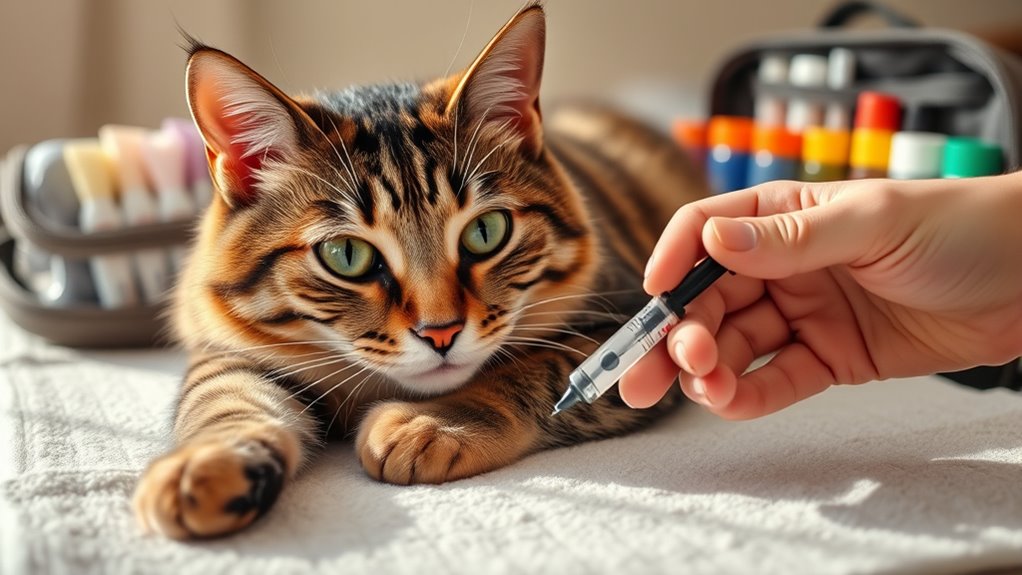To handle a cat emergency, stay calm and assess the situation quickly. Know how to check if your cat is breathing, stop bleeding with gentle pressure, and avoid giving human medications. Keep a first aid kit handy, including antiseptic wipes and gauze, and have emergency vet contacts ready. Recognizing signs of poisoning and acting fast can save your pet’s life. Keep these basics in mind—more helpful tips await to keep your cat safe.
Key Takeaways
- Keep a well-stocked first aid kit with essentials like gauze, antiseptics, and a thermometer.
- Stay calm, assess the situation, and determine if the cat is breathing, responsive, or needs immediate veterinary help.
- Know how to handle common emergencies such as poisoning, bleeding, or choking, and act accordingly.
- Contact your veterinarian or emergency vet promptly for severe injuries, poisoning, or if unsure how to proceed.
- Maintain preparedness by keeping emergency contacts and toxic plant lists accessible, and stay informed on basic first aid techniques.

Accidents can happen suddenly, and knowing basic first aid for your cat can make all the difference in an emergency. When your feline friend is hurt or becomes suddenly ill, your quick response can help prevent further injury or even save their life. The first step is staying calm and evaluating the situation carefully. Check if your cat is conscious, breathing normally, and responsive. If they’re unconscious but breathing, gently keep them warm and comfortable while you prepare to seek professional help. If they’re not breathing, you’ll need to act fast with CPR if you’re trained, but calling your emergency contacts or vet immediately is vital. Having a list of emergency contacts ready means you won’t waste precious time searching for help during a crisis.
Stay calm, assess your cat’s condition, and call for help immediately in emergencies.
One common cause of poisoning in cats is exposure to poisonous plants. Many household plants, such as lilies, philodendrons, and azaleas, are toxic to cats and can cause severe reactions if ingested. If you suspect your cat has eaten a poisonous plant, don’t try to induce vomiting unless instructed by a veterinarian. Instead, remove the plant from their reach immediately and contact your emergency contacts or vet without delay. Keep a list of toxic plants handy so you can quickly identify potential hazards. Also, keep your vet’s phone number and an emergency veterinary clinic’s number accessible at all times. This way, you can get professional advice swiftly, especially if your cat shows signs of poisoning like vomiting, drooling, or difficulty breathing.
It’s also wise to prepare a basic first aid kit tailored for cats. Include sterile gauze, antiseptic wipes, tweezers, and a digital thermometer. If your cat gets a cut or wound, clean it gently with antiseptic and apply pressure to stop bleeding. Never give your cat human medication—many are toxic to felines—unless directed by your vet. In case of ingestion, poisoning, or severe injury, knowing when to contact emergency services and having their contact information ready guarantees you don’t hesitate during critical moments. Additionally, familiarizing yourself with cat-specific first aid techniques can help you respond more effectively. Always remember, while first aid can stabilize your cat temporarily, professional veterinary care is essential for proper treatment.
Being prepared with knowledge, a well-stocked first aid kit, and a list of emergency contacts puts you in a stronger position to handle unexpected situations. Your quick, calm actions can make a significant difference in your cat’s outcome. Keep these essentials in mind, and you’ll be better equipped to respond confidently when your furry friend needs help most.
Frequently Asked Questions
How Can I Tell if My Cat Is in Pain?
You can tell if your cat is in pain by observing changes in behavior and pain indicators. Look for signs like hiding, decreased activity, or aggression. Notice if they’re vocalizing more or less than usual, or if they’re grooming or avoiding certain areas. Changes in posture, difficulty moving, or lack of appetite also signal discomfort. Pay close attention, as these clues help you identify when your cat needs prompt care.
What Are Common Signs of Poisoning in Cats?
Did you know that around 60% of pet poisonings involve household chemicals and plants? If your cat shows vomiting, drooling, diarrhea, or difficulty breathing, it might be poisoning. Watch out for toxic plants like lilies or pothos, and keep household chemicals out of reach. If you notice these signs, act quickly and contact your vet immediately to prevent serious health issues.
How Do I Prevent My Cat From Choking?
To prevent your cat from choking, make certain you provide safe, appropriate-sized cat food and avoid giving them human foods that pose a risk. Regularly check that toys are safe, durable, and free of small parts that could be swallowed. Keep an eye on your cat during meals and playtime, and remove any items that seem unsafe. Practicing cat food safety and toy safety helps minimize choking hazards and keeps your feline healthy.
When Should I Take My Cat to the Vet Immediately?
You should take your cat to the vet immediately if you notice difficulty breathing, bleeding, severe swelling, or if they collapse. During grooming, check for unusual lumps or cuts, and make sure their feline nutrition supports overall health. Quick action in emergencies can save your cat’s life. Regular vet visits, proper grooming, and good nutrition help prevent many issues, ensuring your feline stays healthy and safe.
What First Aid Supplies Should Every Cat Owner Keep?
Think of your first aid kit as a lifeline for your feline friend. Keep essentials like antiseptic wipes, gauze, and adhesive tape handy. Include items for cat nail trims, like nail clippers, and feline dental care supplies such as toothbrushes and dental gel. Having these supplies ready turns you into a hero, ready to handle minor emergencies and keep your cat healthy and happy, just like a guardian angel.
Conclusion
Now that you know the basics of cat first aid, you’re better prepared to handle emergencies. But remember, every second counts, and some situations can escalate quickly. Will you recognize the subtle signs your cat needs help before it’s too late? Stay vigilant, keep your kit ready, and trust your instincts. Your quick action could mean the difference between a close call and a happy, healthy cat. Are you ready to be your feline’s hero?










